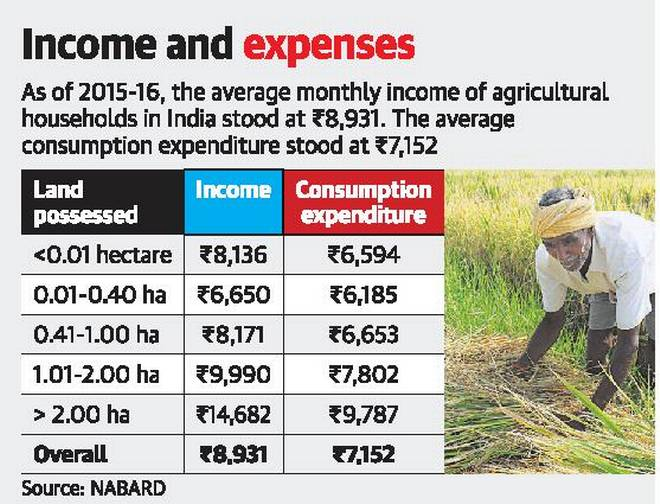.jpg)
In News
Recently, the Centre has admitted that no actual assessment of farm income has been carried out since 2013, when the National Sample Survey Office’s last survey on agricultural households was conducted.
- The government has not provided details on the base year for the goal of doubling farmers income, to be achieved by 2022.
- The impact of the pandemic could have a dampening effect on reaching the goal.

Need to Double Farmers’ Income
- Past strategy for the development of the agriculture sector in India has focused primarily on raising agricultural output and improving food security.
- The net result has been that farmers’ income remained low, which is evident from the incidence of poverty among farm households.
- Low level of absolute income, as well as the large disparity between the income of a farmer and non-agricultural worker, constitute an important reason for the emergence of agrarian distress in the country during the 1990s.
- This distress is spreading and getting severe over time impacting almost half of the population of the country that is dependent on farming for livelihood.
- The country also witnessed a sharp increase in the number of farmer suicides from 1995 to 2004, due to losses from farming.
- The low and highly fluctuating farm income is causing a detrimental effect on the interest in farming and farm investments and is also forcing more and more cultivators, particularly younger age groups, to leave farming.
- It is apparent that income earned by a farmer from agriculture is crucial to address agrarian distress and promote farmers welfare.
- Therefore, the goal set to double farmers’ income by 2022-23 is central to promote farmers welfare, reduce agrarian distress and bring parity between the income of farmers and those working in non-agricultural professions.
Strategies to Achieve Target
- The Government constituted an Inter-ministerial Committee in April 2016 to examine issues relating to Doubling of Farmers Income (DFI).
- The DFI strategy as recommended by the Committee includes seven sources of income growth viz.
- Improvement in crop productivity.
- Improvement in livestock productivity.
- Resource use efficiency or savings in the cost of production.
- Increase in the cropping intensity.
- Diversification towards high-value crops.
- Improvement in real prices received by farmers.
- Shift from farm to non-farm occupations.
Related Schemes
- Pradhan Mantri Kisan Samman Nidhi (PM-KISAN): The Central Sector Scheme aims to provide a payment of Rs. 6000 per year, in three 4-monthly instalments of Rs. 2000 to the farmer’s families, subject to certain exclusions relating to higher-income groups.
- Pradhan Mantri Kisan Maan Dhan Yojana (PM-KMY): It aims to provide old-age pension to farmers.
- It focuses on providing a social security net for Small and Marginal Farmers (SMF) as they have minimal or no savings to provide for old age and to support them in the event of the consequent loss of livelihood.
- Pradhan Mantri Fasal Bima Yojana (PMFBY): It was launched from Kharif 2016 season and provides insurance cover for all stages of the crop cycle including post-harvest risks in specified instances, with a low premium contribution by farmers.
- Per Drop More Crop Initiative: Under it, drip/sprinkler irrigation is being encouraged for optimal utilization of water, reducing the cost of inputs and increasing productivity.
- Paramparagat Krishi Vikas Yojana (PKVY): It aims to promote organic farming.
- Har Medh Par Ped: Under this initiative, agroforestry is being promoted for additional income.
- Pradhan Mantri Annadata Aay Sanrakshan Abhiyan (PM-AASHA): It is aimed at ensuring remunerative prices to the farmers for their produce as announced in the Union Budget for 2018.
- Kisan Credit Card (KCC): The Government has extended the facility of KCC to the farmers practising animal husbandry and fisheries-related activities.
- Operation Greens: It aims to address price volatility of perishable commodities like Tomato, Onion and Potato (TOP).
- PM Kisan Sampada Yojana: It aims to promote food processing in a holistic manner.
- Initiating National Agriculture Market (eNAM): It is a pan-India electronic trading portal which networks the existing APMC mandis to create a unified national market for agricultural commodities.
- National Mission For Sustainable Agriculture (NMSA): It has been formulated for enhancing agricultural productivity especially in rainfed areas focusing on integrated farming, water use efficiency, soil health management and synergizing resource conservation.
- Pradhan Mantri Krishi Sinchayee Yojana (PMKSY): It has been formulated with the vision of extending the coverage of irrigation ‘Har Khet ko pani’ and improving water use efficiency ‘More crop per drop’ in a focused manner with end to end solution on source creation, distribution, management, field application and extension activities.
Suggestions
- Adequate attention needs to be given to improve the welfare of farmers and raise agricultural income.
- In the case of livestock, improvement in herd quality, better feed, increase in artificial insemination, reduction in calving interval and lowering the age at first calving are the potential sources of growth.
- Research institutes should come with technological breakthroughs for shifting production frontiers and raising efficiency in the use of inputs.
- Modern machinery such as laser land leveler, precision seeder and planter, and practices like System of Rice Intensification (SRI), direct-seeded rice, zero tillage, raised bed plantation and ridge plantation allows technically highly efficient farming.
- Research and Development (R&D) institutions should also include in their packages grassroots level innovations and traditional practices that are resilient, sustainable, and income enhancing.
Previous article
Arjun Main Battle Tank
Next article
Detailed Genome Map of Malaria Vector